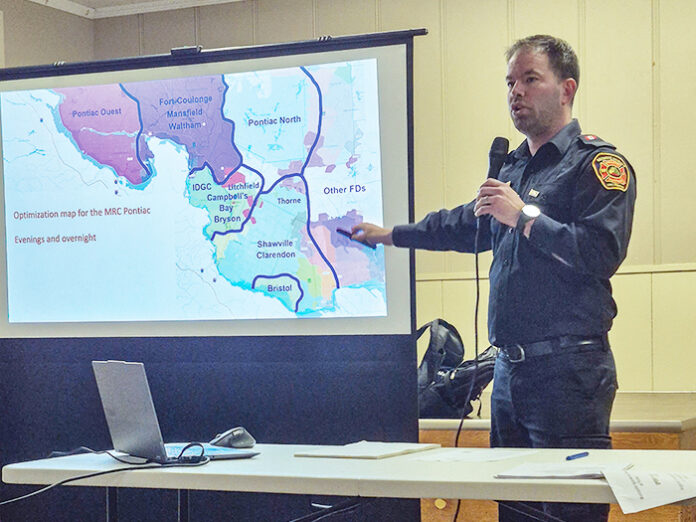Peter L. Smith
Local Journalism Initiative
L’ISLE-AUX-ALLUMETTES – The future of fire services in the MRC Pontiac was the focus of a well-attended public information session held October 9 at the St. Joseph Centre for Families and Seniors.
More than 85 residents gathered to hear Julien Gagnon, MRC Pontiac Public and Civil Security Manager, present a slideshow outlining current challenges and potential changes to regional fire services. Every municipality has a Fire Safety Cover Plan in effect, which is updated every five years.
Gagnon emphasized that while no fire department closures are planned in the immediate future, municipalities are facing mounting costs that are outpacing local budgets. Between 2002 and 2025, fire protection costs have risen by 485%, while municipal budgets have only grown by 199%. Since municipalities are responsible for financing fire services, the financial burden is ultimately passed on to ratepayers. Larger departments have access to some government funding, but it doesn’t cover fire trucks.
“Replacing a fire truck costs on average $700,000 without financing,” said Gagnon. “The average age of our 46 front-line fire vehicles is 21.3 years.”
The MRC Pontiac’s fire departments include 233 firefighters across nine departments, though only about 50 are typically available during daytime hours. Some firefighters volunteer in multiple departments, helping to fill gaps when needed.
In 2018, the MRC commissioned consultant Richard Lefebvre, former Rouyn-Noranda fire chief, to conduct a study on the feasibility of merging fire services. The findings highlighted equipment inconsistencies between departments — such as hoses and hydrant fittings of varying sizes — which could complicate joint responses to major fires. Additionally, several municipalities have non-conforming hydrant networks, requiring tanker operations to sustain water flow during emergencies.
Gagnon outlined several possible initiatives:
• Cross-border response to ensure the closest available truck responds to an emergency;
• Better back-up for simultaneous calls;
• Shared administration and apparatus’ to stretch tax dollars;
• Standardized training, equipment, and operating procedures;
• Coordinated prevention and inspection efforts across departments;
The study noted a regional apparatus strategy (sharing, redeployment, common specs) could reduce the overall number of vehicles needed while maintaining — and even improving — service reliability. Early estimates suggest the replacement of 10 vehicles could be avoided.
As for governance models, Gagnon said options being studied include a MRC-managed regional fire service, an intermunicipal régie, or expanded intermunicipal agreements.
“No final decision will be made until a complete agreement is drafted by a joint committee and adopted by each council, likely in mid-2026,” Gagnon stated.
He stressed that some fire departments within the MRC are already combined to improve service and reduce costs.
“Integrating fire departments should be seen as strengthening local service, not erasing it,” Gagnon added.
However, not everyone was optimistic about the proposed changes. Waltham Fire Chief Larry Perry, who is set to retire at the end of the year, voiced concern.
“I believe these new initiatives will not encourage more volunteers to step forward,” said Perry. “Things are working well in Waltham. Our trucks are well maintained and our firefighters are continually training. Expecting eight volunteer firefighters to be available at any given time is unrealistic when most have full-time jobs, some outside their towns.”
Photo: MRC Pontiac Public Security Manager Julien Gagnon gives a
presentation on the future of fire services in the Pontiac at a public information session held October 9 in Chapeau.





